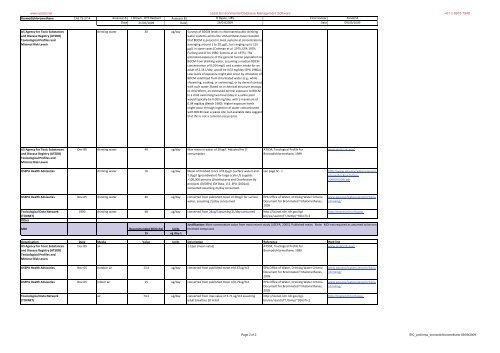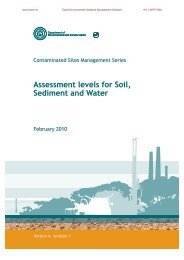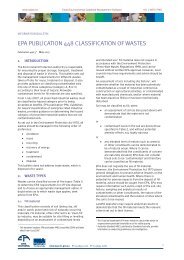Soil Generic Assessment Criteria for Human Health Risk ... - ESdat
Soil Generic Assessment Criteria for Human Health Risk ... - ESdat
Soil Generic Assessment Criteria for Human Health Risk ... - ESdat
Create successful ePaper yourself
Turn your PDF publications into a flip-book with our unique Google optimized e-Paper software.
www.esdat.net Esdat Environmental Database Management Software +61 2 8875 7948<br />
Bromodichloromethane CAS 75-27-4 Assessor A: J Brown - DTS Raeburn Assessor B: D Dyson, URS Final review: Panel/SF<br />
Date 21/05/2009 Date 25/03/2009 Date 09/09/2009<br />
US Agency <strong>for</strong> Toxic Substances<br />
and Disease Registry (ATSDR)<br />
Toxicological Profiles and<br />
Minimal <strong>Risk</strong> Levels<br />
drinking water 30 ug/day Surveys of BDCM levels in chlorinated public drinking<br />
water systems across the United States have revealed<br />
that BDCM is present in most systems at concentrations<br />
<br />
<br />
Furlong and D'itri 1986; Symons et al. 1975). The<br />
estimated exposure of the general human population to<br />
BDCM from drinking water, assuming a median BDCM<br />
concentration of 0.014 mg/L and a water intake <strong>for</strong> an<br />
adult of 2.18 L/day, would be 0.03 mg/day (EPA 1980a).<br />
Low levels of exposure might also occur by inhalation of<br />
BDCM volatilized from chlorinated water (e.g., while<br />
showering, cooking, or swimming), or by dermal contact<br />
with such water. Based on a chemical structure analogy<br />
to chloro<strong>for</strong>m, an estimated dermal exposure to BDCM<br />
in a child swimming two hours/day in a saline pool<br />
would typically be 0.003 mg/day, with a maximum of<br />
0.04 mg/day (Beech 1980). Higher exposure levels<br />
might occur through ingestion of water contaminated<br />
with BDCM near a waste site, but available data suggest<br />
that this is not a common occurrence.<br />
US Agency <strong>for</strong> Toxic Substances<br />
and Disease Registry (ATSDR)<br />
Toxicological Profiles and<br />
Minimal <strong>Risk</strong> Levels<br />
Dec-89 drinking water 40 ug/day Max mean in water of 20ug/l. Adjusted <strong>for</strong> 2l<br />
consumption<br />
ATSDR, Toxological Profile <strong>for</strong><br />
Bromodichlormethane, 1989<br />
www.atsdr.cdc.gov/<br />
USEPA <strong>Health</strong> Advisories drinking water 16 ug/day Mean of finished concs of 8.2μg/l (surface water) and<br />
7.9μg/l (groundwater) <strong>for</strong> large-scale US supplies<br />
>100,000 persons (Disinfectants and Disinfection By<br />
products (D/DBPs) ICR Data, U.S. EPA (2001a)).<br />
Converted assuming 2L/day consumed.<br />
see page IV - 1<br />
http://www.epa.gov/waterscience/c<br />
riteria/drinking/brthm-<br />
200605(508).pdf<br />
USEPA <strong>Health</strong> Advisories Nov-05 drinking water 40 ug/day converted from published mean of 20ug/l <strong>for</strong> surface<br />
water, assuming 2L/day conscumed<br />
Toxicological Data Network<br />
(TOXNET)<br />
Other<br />
EPA Office of Water, Drinking Water <strong>Criteria</strong><br />
Document <strong>for</strong> Brominated Trihalomethanes,<br />
2005<br />
MDI Recommended MDIinhal Units<br />
15 ug day-1<br />
www.epa.gov/waterscience/criteria<br />
/drinking/<br />
http://toxnet.nlm.nih.gov/<br />
Justification: Most conservative value from most recent study (USEPA, 2005). Published mean. Note: MDI not required as assumed to be non<br />
threhold compound<br />
Organisation Date Media Value Units Description Reference Web link<br />
US Agency <strong>for</strong> Toxic Substances<br />
and Disease Registry (ATSDR)<br />
Toxicological Profiles and<br />
Minimal <strong>Risk</strong> Levels<br />
Dec-89 air 1.1ppt (mean value) ATSDR, Toxological Profile <strong>for</strong><br />
Bromodichlormethane, 1989<br />
www.atsdr.cdc.gov/<br />
USEPA <strong>Health</strong> Advisories Nov-05 outdoor air 13.4 ug/day converted from published mean of 0.67ug/m3 EPA Office of Water, Drinking Water <strong>Criteria</strong><br />
Document <strong>for</strong> Brominated Trihalomethanes,<br />
2005<br />
USEPA <strong>Health</strong> Advisories Nov-05 indoor air 15 ug/day converted from published mean of 0.75ug/m3 EPA Office of Water, Drinking Water <strong>Criteria</strong><br />
Document <strong>for</strong> Brominated Trihalomethanes,<br />
2005<br />
Toxicological Data Network<br />
(TOXNET)<br />
air 74.2 ug/day converted from max value of 3.71 ug/m3 assuming<br />
adult breathes 20 m3/d<br />
1990 drinking water 48 ug/day converted from 24ug/l assuming 2L/day consumed http://toxnet.nlm.nih.gov/cgibin/sis/search/f./temp/~92koTn:2<br />
http://toxnet.nlm.nih.gov/cgibin/sis/search/f./temp/~92koTn:2<br />
www.epa.gov/waterscience/criteria<br />
/drinking/<br />
www.epa.gov/waterscience/criteria<br />
/drinking/<br />
http://toxnet.nlm.nih.gov/<br />
Page 2 of 2 EIC_pro<strong>for</strong>ma_bromodichloromethane 09/09/2009








